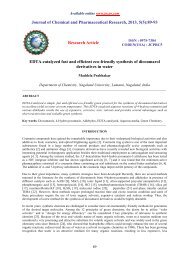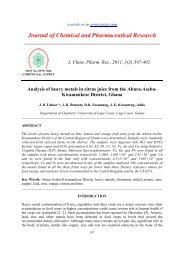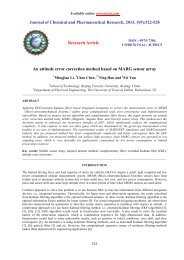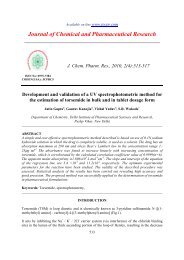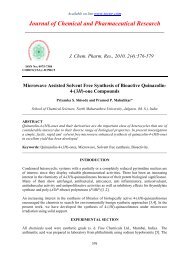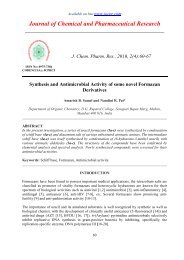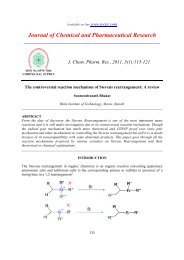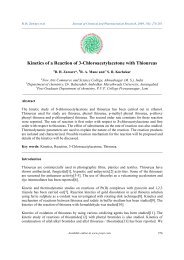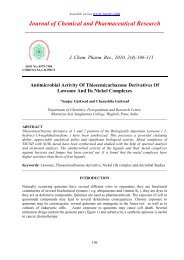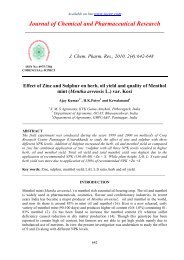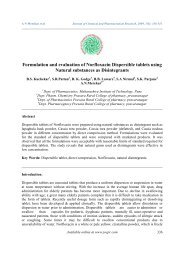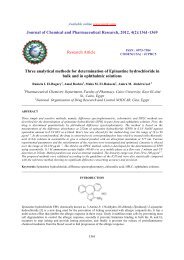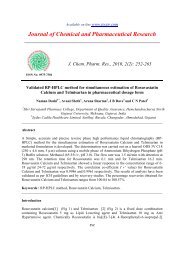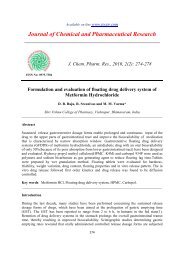Synthesis of some 2-methyl-5-nitroimidazole derivatives - Journal of ...
Synthesis of some 2-methyl-5-nitroimidazole derivatives - Journal of ...
Synthesis of some 2-methyl-5-nitroimidazole derivatives - Journal of ...
Create successful ePaper yourself
Turn your PDF publications into a flip-book with our unique Google optimized e-Paper software.
Manisha N. Trivedi et al J. Chem. Pharm. Res., 2011, 3(1):313-319<br />
______________________________________________________________________________<br />
All the synthesized compounds were purified by recrystallisation with suitable solvents. The<br />
purity <strong>of</strong> all the synthesized compounds were checked by their melting point and thin layer<br />
chromatographic pattern. The melting points were determined in open capillaries by using Expo-<br />
HiTech melting point apparatus. The Rf values were found out by thin layer chromatography<br />
using precoated silica gel G plates as stationary phase and a suitable mobile phase. Detection was<br />
done by exposure to UV radiation and iodine vapours. The structures <strong>of</strong> synthesized compounds<br />
were characterized by their infrared spectra using Jasco FTIR-4100 and Jasco FTIR-5300. Mull<br />
method and KBr disc method was used to record IR spectra. The structures <strong>of</strong> synthesized<br />
compounds were characterized and confirmed by recording their NMR spectra using VNMRS-<br />
300 spectrometer, 300MHz. Deuteriated chlor<strong>of</strong>orm carbon tetrachloride and di<strong>methyl</strong><br />
sulphoxide were the solvents used for recording NMR spectra. Tetra<strong>methyl</strong> silane was used as<br />
the reference standard. The structures <strong>of</strong> <strong>some</strong> synthesized compounds were also confirmed by<br />
Mass spectrum analysis. Table 1 and 2<br />
<strong>Synthesis</strong> <strong>of</strong> 1-<strong>methyl</strong>-2-(2-<strong>methyl</strong>-5-nitro-1H-imidazol-1-yl)ethyl octadecanoate (Compound A)<br />
Mixture <strong>of</strong> Stearic acid (1g, 3.52 mmoles) and thionyl chloride (0.5ml, 6.87 mmoles) was<br />
refluxed at 65 o C for one hour by placing calcium chloride guard tube on reflux condenser to<br />
absorb the hydrogen chloride gas formed during reaction. Stearoyl chloride thus formed was<br />
highly fuming and immediately reacted with mixture <strong>of</strong> secnidazole (1g, 5.4 mmoles) and<br />
pyridine (0.5ml, 6.20mmoles). The reaction beaker was intermediately kept on ice bath to cool<br />
the beaker heated by reaction between stearoyl chloride, secnidazole and pyridine. The solid<br />
separated after stirring for 5-10 minutes was cooled and recrystallised using hot methanol.<br />
<strong>Synthesis</strong> <strong>of</strong> 1-<strong>methyl</strong>-2-(2-<strong>methyl</strong>-5-nitro-1H imidazol-1-yl) ethyl hexadecanoate (Compound<br />
B) and <strong>Synthesis</strong> <strong>of</strong> 1-<strong>methyl</strong>-2-(2-<strong>methyl</strong>-5-nitro-1H-imidazol-1-yl) ethyl tetradecanoate<br />
(Compound C) were carried out in similar manner.<br />
<strong>Synthesis</strong> <strong>of</strong> 1-<strong>methyl</strong>-2-(2-<strong>methyl</strong>-5-nitro-1H imidazol-1-yl) ethyl 4-nitrobenzoate (Compound D)<br />
Mixture <strong>of</strong> p-Nitrobenzoic acid (1.0g, 6mmoles) and phosphorous pentachloride (1.3g, 6mmoles)<br />
was refluxed at 70 o C for one hour by placing calcium chloride guard tube on reflux condenser to<br />
absorb the hydrogen chloride gas formed during reaction. A pale yellow homogenous liquid <strong>of</strong> p-<br />
Nitrobenzoyl chloride which solidifies and separates as fine yellow needles melting at 71-73 o C<br />
was immediately reacted with mixture <strong>of</strong> secnidazole (1g, 5.4 mmoles) and pyridine (0.8ml,<br />
10mmoles). The reaction beaker was intermediately kept on ice bath to cool the beaker heated<br />
by reaction between p-Nitrobenzoyl chloride, secnidazole and pyridine. After completion <strong>of</strong><br />
reaction 10-15ml <strong>of</strong> 2% sodium hydrogen carbonate solution was added to the reaction mixture<br />
and solid thus separated was washed with water, filtered and dried. Recrystallised using hot<br />
methanol giving yellow colored crystals.<br />
<strong>Synthesis</strong> <strong>of</strong> 1-<strong>methyl</strong>-2-(2-<strong>methyl</strong>-5-nitro-1H-imidazol-1-yl) ethyl 3-nitrobenzoate (Compound<br />
E) and <strong>Synthesis</strong> <strong>of</strong> 1-(2-<strong>methyl</strong>-5-nitro-1H-imidazol-1-yl)propan-2-yl 3,5-dinitrobenzoate<br />
(Compound F) were carried out in similar manner.<br />
<strong>Synthesis</strong> <strong>of</strong> 2-{[1-<strong>methyl</strong>-2-(2-<strong>methyl</strong>-5-nitro-1H-imidazol-1yl)ethoxy]carbonyl}benzoic acid<br />
(Compound G)<br />
Mixture <strong>of</strong> Secnidazole (1.0g, 5.4mmoles) and pyridine (1.0ml, 12.4mmoles) were placed in<br />
porcelain dish and stirred on water bath to dissolve secnidazole. To it phthalic anhydride (1.0g,<br />
316



